TO
| Title | Date | Subject | Description | ||
|---|---|---|---|---|---|
| 26 |
 |
Classification of natural bitumen: A physical and chemical approach | 1987 | natural bitumen; Classification of bitumen; physical properties of natural bitumen; chemical properties of natural bitumen; crude oil; natural bitumen; tar sands oil; bitumen | By correlation of various selected physical and chemical properties of heavy crude oils and natural bitumens, an attempt is made to solve classification problems. The criteria used here are, in descending order: viscosity, gravity, H/C atomic ratio, O/C atomic ratio, optical reflectivity; volatiles,... |
| 27 |
 |
California plio-miocene oils: Evidence of early generation | 1987 | plio-miocene oils; California oil; source rocks; commercial generation; LOM; hydrocarbon concentration; oil quality | Early generation of oil from Monterey and equivalent source rocks may well be the primary controlling factor on oil quality in the coastal basins of California. Commercial generation has occurred at reflectance levels as low as 0.3% R0. The wide range of chemical characteristics of these oils is com... |
| 28 |
 |
An echoing in-situ combustion oil recovery project in a Utah tar sand | 1982 | in-situ combustion; oil recovery project; Utah tar sand; echoing in-situ; U.S. tar sand resources; reverse combustion process; heterogeneous tar sand reservoir | U.S. tar sand resources contain an estimated 30 billion bbl (4.7 Gm3) of oil in place in about 550 occurrences in 22 states. Over 90% of the known resources are in six large deposits in Utah, each containing from 1 to 16 billion bbl (0.15 to 2.5 Gm3) of oil. 1 Four major tar sand deposits in Alberta... |
| 29 |
 |
Field experiment of in-situ oil recovery from a Utah tar sand by reverse combustion | 1976 | in-situ oil recovery; Utah tar sand; reverse combustion; oil recovery | Part of the mission of the Energy Research and Development Administration (ERDA) is to develop all energy sources to meet the needs of present and future generations. Toward that mission the Laramie Energy Research Center (LERC) is conducting research and field experiments for the development of rec... |
| 30 |
 |
Association of uranium and other metals with crude oil, asphalt, and petroliferous rock | 1954-10 | uranium; crude oil; asphalt; petroliferous rock | Some crude oil, natural asphalt, and petroliferous rock are appreciably radioactive, but little is known about the actual uranium content and the chemical nature of the uranium compound or compounds in these materials. Semiquantitative spectrographic analyses of the ash of 29 samples of crude oil, 2... |
| 31 |
 |
Diluent-assisted hot-water processing of tar sands | 1987 | hot water processing; tar sands; diluent-assisted hot-water processing; bitumen viscosity | The influence of diluent addition and temperature on bitumen viscosity of tar sands from nine locations in the U.S.A. and Canada has been investigated. Subsequently, hot-water bitumen-recovery experiments were carried out at temperatures from 33°C to 95°C. Kerosene was added as needed to maintain ... |
| 32 |
 |
Bitumen deposits of northwest Alabama | 1987 | bitumen deposits; northwest Alabama deposits; bituminous rocks | Bituminous rocks of Mississippian age crop out in northwest Alabama within a 113-km (70-mi) long belt. Bitumen deposits have been confirmed by coreholes to be present in the subsurface for a distance of at least 16-24 km (10-15 mi) south of the outcrop. Geochemical analyses indicate the bitumen to b... |
| 33 |
 |
Census 2010 - a first look at Utah results | 2011 | Census; 2010; Utah; Demographics; Population; Age; Sex; Race; Ethnicity | Early results from the long-awaited 2010 Census are revealing the outlines of the more detailed portrait that will not be available for at least a couple more years. This essay reviews the top-level population change and geographic distribution results primarily from the redistricting data set.1 We ... |
| 34 |
 |
The coming boom in Utah's school age and college age populations: state and county scenarios | 2002-09 | Population analysts have for some time anticipated a significant increase in the school age population (5 through 17 years of age) of Utah beginning around 2004 and extending for at least a decade. At this point the question is not whether the boom will materialize, but rather, the exact timing, mag... | |
| 35 |
 |
Revised Utah population estimates for the 1990s | 2001-05 | Every 10 years, the U.S. Bureau of the Census conducts a population count. In the intervening years the Utah Population Es timates Committee (UPEC) annually prepares total resident population estimates for each of the 29 counties in the state. These estimates are based on methods that ut i l i z e s... | |
| 36 |
 |
Immigrants transform Utah: entering a new era of diversity | 2004-05 | Utah is generally perceived as an extremely homogeneous state whose population can trace its ancestry mostly to northern Europe. Listings for surnames like Hansen, Jensen, and Christensen do fill many pages in local telephone directories throughout the state. According to census counts, the minority... | |
| 37 |
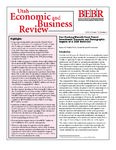 |
Fast-tracking Wasatch Front transit investments: economic and demographic impacts of a 2025 build-out | 2011 | Over the next 30 years, the Wasatch Front will significantly expand its transit network. Plans include the construction of an additional 25 miles of light rail, 76 miles of commuter rail, 227 miles of bus rapid transit, and 29 miles of mountain transportation rail line. These projects will be built ... | |
| 38 |
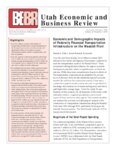 |
Economic and demographic impacts of federally financed transportation infrastructure on the Wasatch Front | 2004-09 | Over the next three decades, $14.4 billion (constant 2004 dollars) of new transit and highway infrastructure is planned to meet the transportation needs of the Wasatch Front.1 These investments will significantly influence the region's economic development potential, relative competitiveness, and la... | |
| 39 |
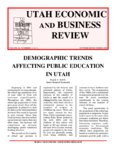 |
Demographic trends affecting public education in Utah | 2000-11 | Beginning in 2004 and continuing for at least a decade, the school age population (5 to 18 year olds) in Utah will increase significantly. Throughout the 1990s, the school age population in Utah grew more slowly than did the population in general so that its share in the total population declined. T... | |
| 40 |
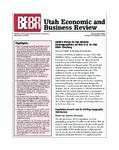 |
Utah's place in the macro-demographics of the U.S. in the 20th century | 2006-03 | Utah has evolved from an isolated rural state of fewer than 300,000 in 1900 to a mostly urban state of 2.5 million today. This paper is an attempt to place this population growth within the context of the broadest outlines of national population dynamics over the past century. The growth and regiona... | |
| 41 |
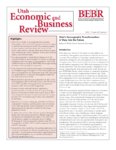 |
Utah's demographic transformation: a view into the future | 2008 | Utah, along with the rest of the nation, is in the midst of an extraordinary demographic transformation which has far from run its course. The confluence of four major trends continues to dramatically reshape the size and composition of the national and state populations. These trends include the ar... | |
| 42 |
 |
Salt Lake County's distinctive demographics: implications for the future | 2006-11 | Salt Lake County is the economic, political, and cultural center of Utah. The county is currently home to nearly 40% of Utah residents and generates about half of all jobs in the state. It remains the most populous county, with a million of the state's 2.6 million residents,2 and its daytime populat... | |
| 43 |
 |
Experimental and modeling study of particulate formation in high-pressure diesel-like conditions | 2000 | particulate formation; high-pressure diesel-like conditions; diesel combustion process; tailpipe particulate emissions | The diesel combustion process has been characterized by combined measurements of flame intensity and extinction in the UV-visible range in an optically accessible divided-chamber diesel engine at different air/fuel ratios and constant engine speed, using n-heptane and commercial diesel oil as fuels.... |
| 44 |
 |
Mechanism and kinetics of lead capture by kaolinite in a downflow combustor | 2000 | mechanism and kinetics; lead capture; kaolinite; downflow combustor; postflame reaction; lead vapor | An 18 kW, 6 m long, gas-fired downflow combustor was used to examine the postflame reaction between lead vapor and kaolinite. Since the focus of this work was to evaluate the reaction with lead vapor, samples were extracted at a temperature above the metal dew point. The sample was rapidly diluted w... |
| 45 |
 |
In-furnace capture of cadmium and other semi-volatile metals by sorbents | 2005 | in-furnace capture; cadmium capture; semi-volatile metals; sorbents; sorbent utilization | An 18 kW, cylindrical (inside diameter = 15-cm), 6-m high, laminar, downflow furnace was used to investigate the mechanisms governing reactive scavenging of cadmium vapors from combustion environments, by hydrated lime and kaolinite powder sorbents. Two major physical mechanisms dominate the reactio... |
| 46 |
 |
Parallelization of the P-1 radiation model | 2006 | parallelization; P-1 radiation model; radiative transport equation; LES; large-eddy simulations; RTE | The P-1 radiation model is spatially decomposed to solve the radiative transport equation on parallel computers. Mathematical libraries developed by third parties are employed to solve the linear systems that result during the solution procedure. Multigrid preconditioning accelerated the convergence... |
| 47 |
 |
Biofuels--snake oil for the twenty-first century | 2008-12-01 | Most Americans are painfully aware that our present consumption of petroleum is unsustainable. The United States has less than 5% of the world's population, but consumes 24.4% of the world's petroleum production. Only 8.5% of the world's petroleum production comes from American wells, which necessit... | |
| 48 |
 |
Importance of bitumen viscosity in the hot water processing of domestic tar sands | 1983 | bitumen viscosity; hot water processing; domestic tar sands; bitumen recovery | The separation efficiency of the hot water digestionflotation technique used for bitumen recovery from various domestic tar sands was evaluated. Bitumen viscosity was found to be the most important tar sand property in determining the success of the bitumen separation. Bitumen viscosity of the tar s... |
| 49 |
 |
Nitric oxide destruction during coal and char oxidation under pulverized-coal combustion conditions | 2004 | nitric oxide destruction; coal and char oxidation; pulverized-coal combustion; particle distribution; conversion efficiency | A modified drop-tube reactor that allows particle distribution over the reactor cross-sectional area, and oxidation of chars produced in situ, was used to study the conversion efficiency of char nitrogen to nitric oxide (aNO). The results confirm previous findings by other investigators that aNO dec... |
| 50 |
 |
High-temperature interactions between multiple-metals and kaolinite | 2002 | high-temperature interactions; multiple-metals; kaolinite | High-temperature combustion flue gases provided the environments for this investigation of multiple-metals interactions with dispersed kaolinite. Whereas previous research was restricted to interactions of single-metals with kaolinite powders, this work focuses on understanding how kaolinite transfo... |
